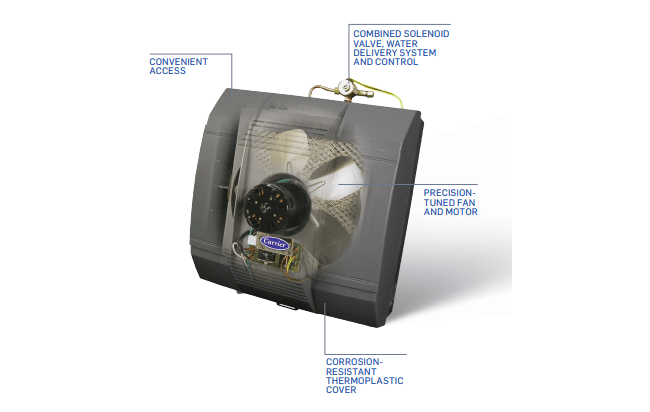What Does a Humidifier Do?
By Travis Baugh
Wondering what is a humidifier and what does it do? In this guide, we'll answer those questions, as well as how does a humidifier work, how to choose the right humidifier for your home, and whole home humidifier maintenance best practices. Let's dive in!

What Is A Humidifier? What Does A Humidifier Do?
How Does a Humidifier Work?
Understanding how a humidifier functions can aid you in making an informed decision about whether it's the right solution for your home. Essentially, humidifiers work by adding moisture to the air through various mechanisms, depending on the type of humidifier. Common types include evaporative, ultrasonic, and steam humidifiers.
Evaporative humidifiers employ a fan to blow air through a wet wick or filter, facilitating water evaporation and increasing humidity. Ultrasonic humidifiers utilize ultrasonic vibrations to create a fine mist of water droplets that are dispersed into the air. A steam humidifier delivers humidity in the form of steam to the conditioned space.
Regardless of the type, all humidifiers feature a mechanism to control and regulate humidity levels. If equipped with a control that includes a humidistat or hygrometer, these devices can measure the humidity in the air and adjust their operation to maintain the desired moisture levels.
“A whole-home humidifier adds moisture to the air throughout your house,” Kevin Dickson, president of Energy Services Air Conditioning, Heating and Electrical in Naperville, Illinois, said. “It works by passing the warm air from your heating system over an evaporative pad, which allows water to evaporate into the air and raise humidity levels evenly in every room.
"Maintaining proper humidity isn’t just about comfort — it can help prevent dry skin, reduce static electricity, protect wood floors and furniture from cracking, and even help your heating system operate more efficiently.”

Parts of a Whole Home Humidifier
Choosing the Right Whole Home Humidifier for Your Needs
- Type of Humidifier: There are various types of humidifiers available, including steam humidifiers, fan-powered humidifiers, and bypass humidifiers.
- Home Size: One of the first factors to consider is the size of your home. Different humidifiers are designed to accommodate various home sizes, so it's crucial to choose one that can effectively humidify the space you have in mind. Carrier offers a range of humidifiers suitable for different home sizes, ensuring optimal performance and comfort. Steam humidifiers offer the most presise humidity control for all homes, fan-powered humidifiers better suited than bypass humidifiers for large homes, while bypass humidifiers may be a better option for medium and smaller sized homes or where energy consumption of the humidifier fan is a concern.
- Additional Features: Consider additional features that may enhance your humidifier experience, such as water vapor output, capacity (gallons/day) and the unit’s warranty.
Do Humidifiers Work?
Maintaining Your Whole Home Humidifier
- Changing Humidifier Pads: If your humidifier has an evaporative humidifier pad, replace it as recommended by the manufacturer. A clean humidifier pad ensures the device operates efficiently and maintains good air quality.
- Periodic Maintenance: See owner’s manual for periodic maintenance and service instructions.
- Annual Summer Shutdown: See owner’s manual for summer shutdown procedures where applicable.
Carrier Whole Home Humidifiers
Frequently Asked Questions About Whole Home Humidifiers
Learn More About Whole-House Humidifiers
- Choosing the best humidifier for your home
- Cost to Buy or Replace a Whole-Home Humidifier
- Furnaces and Humidifiers: How They Work Together
- Breathe easier with better indoor air quality at home
- Learn the difference between a humidifier vs dehumidifier
- Discover what humidity should be house be at?

